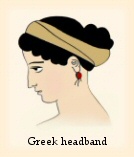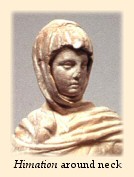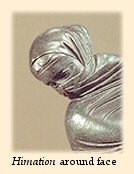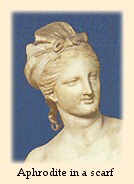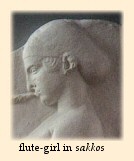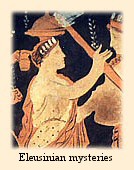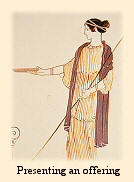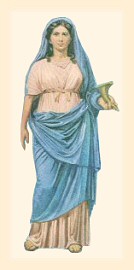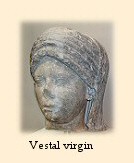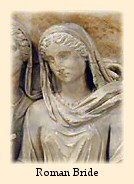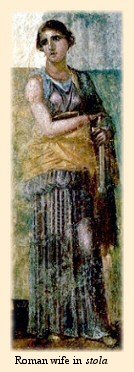Headcovering Customs of the Ancient World
An Illustrated Survey, by Michael Marlowe
I offer this survey of ancient headcovering practices in the hope that it will clear away some common misconceptions, and bring into sharper focus the customs which many biblical expositors have held to be so important for an understanding of the Apostle Paul's instruction to the Corinthians regarding headcoverings. Too often I find that the statements made by biblical expositors on this subject are inaccurate and simplistic. The more research I have done on the subject, the more I have come to see how problematic is the widely-accepted interpretation of 1 Corinthians 11:2-16 which asserts that Paul is merely urging the saints in Corinth to conform to local and secular customs. In my opinion this idea raises more problems than it solves.
I conclude that Paul's explanations pertain to an established Christian custom, which may or may not have corresponded to any Jewish, Greek, or Roman custom of the time. Most "cultural background" treatments of this subject have failed to recognize the importance of the fact that in the first century the Church was itself a sub-culture, having its own traditions and customs.
This survey was prepared as a supporting document for my exegetical commentary on 1 Corinthians 11:2-16, to which I refer the reader for more specific comments on Paul's explanation of the early Christian custom.
Michael D. Marlowe
February 2005
Ancient Dress in General
 In ancient times men did not wear trousers, and women did not wear skirts. There were no shirts or blouses such as we wear today, either. Both sexes usually wore flowing garments comparable to the modern woman's dress. (1) In the Greek language the basic article of clothing was called the chiton (χιτών), and in the Latin language it was called the tunica. (2) In general, women wore a long chiton that reached all the way to the ankles. Over the chiton another garment, called the himation (ἱμάτιον), was worn (see figure 1). In the Latin language this was called the palla (for women) or the pallium (for men). The toga was a garment like the pallium, more elaborately draped, and worn only by Roman citizens. These upper garments (himation, pallium, toga) were just large oblong pieces of cloth wrapped around the body in various ways.
In ancient times men did not wear trousers, and women did not wear skirts. There were no shirts or blouses such as we wear today, either. Both sexes usually wore flowing garments comparable to the modern woman's dress. (1) In the Greek language the basic article of clothing was called the chiton (χιτών), and in the Latin language it was called the tunica. (2) In general, women wore a long chiton that reached all the way to the ankles. Over the chiton another garment, called the himation (ἱμάτιον), was worn (see figure 1). In the Latin language this was called the palla (for women) or the pallium (for men). The toga was a garment like the pallium, more elaborately draped, and worn only by Roman citizens. These upper garments (himation, pallium, toga) were just large oblong pieces of cloth wrapped around the body in various ways.
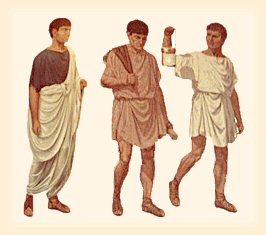 Often a man would wear only the chiton. Working men would typically wear a short chiton which did not reach the knees (figure 2). This was to give free movement to their legs while running or working. The length of the chiton was adjusted by pulling it up over a belt. Sometimes a man would wear only the himation, without the chiton, but this manner of dress was unusual — it was associated with philosophers and religious ascetics. In general, it should be noted that women were more fully covered up with clothes than men were, and women's garments were often dyed in brighter colors.
Often a man would wear only the chiton. Working men would typically wear a short chiton which did not reach the knees (figure 2). This was to give free movement to their legs while running or working. The length of the chiton was adjusted by pulling it up over a belt. Sometimes a man would wear only the himation, without the chiton, but this manner of dress was unusual — it was associated with philosophers and religious ascetics. In general, it should be noted that women were more fully covered up with clothes than men were, and women's garments were often dyed in brighter colors.
There are a number of ancient texts and artifacts which clearly indicate that headcovering customs varied from time to time and from place to place. Some of these customs pertained specifically to religious cults, ceremonies, offices, and exercises. Some of them pertained to women, and others to men. I will discuss the customs of the Greeks, Romans, and Jews separately below. But it is important to recognize that in the first century there was a mixture of cultures throughout the Mediterranean lands: many Jews even in Palestine had become "Hellenized" (imitating the Greeks); several cities on Greek soil were founded or refounded as Roman colonies; in Rome there was a great influx of people from Greece and other regions, and much of the population there spoke Greek. Greek-speaking Jews had spread all over the ancient world. So it is likely that in any given city there were various customs connected with different ethnic groups, and this is especially likely to have been the case in a city like Corinth.
Greek Customs of Dress
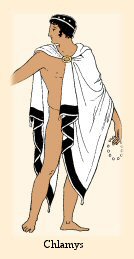
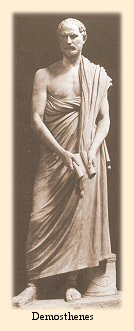
Among the Greeks it seems that men did not ordinarily wear anything on their heads for worship of their gods, or in public generally. It is well-known that Greek men tended to minimize their clothing. Even nudity was not considered shameful among them in certain contexts. Because the climate in Greece is warm, men would sometimes wear nothing more than a scanty mantle called a chlamys fastened around the right shoulder, leaving the entire right side of their bodies exposed (figure 3). Sometimes a man would wear only the himation (figure 4), and it was customary for philosophers and poets to dress in this manner.
Greek women were expected to fully cover their bodies. For instance, a woman would not gird up her chiton like a man and display her legs in public. But the Greek headcovering customs for women during the first century are hard to determine with any degree of certainty. In the past, some biblical expositors casually asserted that all respectable Greek women wore headcoverings, and that among the Greeks (as among the Jews) only disreputable women went about with bare heads. But there does not seem to be any good evidence for this in ancient sources. (3) Many scholars now maintain that although Greek women certainly did wear headcoverings at times, and probably more often than not in public, there is no good reason to think that Greek women were under some compulsion to cover their heads in public. The idea that immoral women were recognized as such by the absence of a headcovering has no basis at all in ancient evidence.
Our most important sources of information about the clothing of Greek women are the many depictions of women to be found on ancient pottery. These depictions usually show women with their hair done up in a knot and wearing a band of cloth wrapped around the head to keep the hair in place, but these bands do not cover the head on top (figure 5 and figure 22), and sometimes there is no hair-band (figure 27). We should beware of putting too much weight upon this evidence, however, because it may be that in these illustrations the women are depicted without headcoverings because they are at home, and perhaps it was merely a convention of Greek art to portray women in this way. It is hard to tell from the depictions alone whether or not the women are in a public setting.
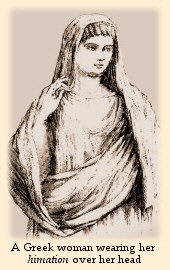 In the ancient illustrations and sculptures that do show Greek women with covered heads, the headcovering is usually just the himation pulled over the top and back of the head (figure 6). Sometimes it is shown over the head and wrapped around the neck, without covering the face (figure 7). One famous artifact (a bronze statuette in the Metropolitan Museum of Art) shows a woman with her himation wrapped across the lower part of her face (figure 8), but this is unusual. The statuette portrays a dancer, and some scholars think that it was made in Alexandria (4) Many illustrations show women wearing a himation around one or both shoulders, without having it over their heads.
In the ancient illustrations and sculptures that do show Greek women with covered heads, the headcovering is usually just the himation pulled over the top and back of the head (figure 6). Sometimes it is shown over the head and wrapped around the neck, without covering the face (figure 7). One famous artifact (a bronze statuette in the Metropolitan Museum of Art) shows a woman with her himation wrapped across the lower part of her face (figure 8), but this is unusual. The statuette portrays a dancer, and some scholars think that it was made in Alexandria (4) Many illustrations show women wearing a himation around one or both shoulders, without having it over their heads.
Aside from the himation, there are other headcoverings in the ancient pictures also. A woman might wear a scarf tied closely around her hair (figure 9), a small shawl draped over her head (called a kaluptra, resembling the modern mantilla), or a kind of snood, called a sakkos (figure 10). Sometimes snoods and scarves are seen on women who are depicted nude, and here obviously the coverings were merely ornamental, and not worn because of any ideas about proper dress. Still less do they symbolize modesty, or marriage, or anything of the sort. None of these pictures or artifacts prove (or disprove) what Greek women were expected to wear in public.
One statement commonly cited as evidence about the headcovering customs of Greek women is in Plutarch's Sayings of Spartans (written during the first century a.d.). Concerning a Spartan he writes, "When someone inquired why they took their girls into public places unveiled, but their married women veiled, he said, 'Because the girls have to find husbands, and the married women have to keep to those who have them!'" (5) This seems to indicate that in Sparta married women usually covered their heads in public and unmarried women did not. But there are a few considerations which lessen the usefulness of this statement. For one thing, Plutarch's purpose here is to record an amusing saying, not to describe a current custom. For another, it should be borne in mind that ancient Greece was not a monolithic culture: customs varied fom city to city in Greece, and the customs of Sparta are often mentioned as being peculiar, different from those of Athens and other cities. Finally, it should perhaps be noted that the Spartan to whom the saying is attributed is one Charillus, a king of Sparta in the eighth century b.c. In the same work, Plutarch also attributes to this Charillus a saying "in answer to the man who inquired why they [i.e. the men] wore their hair long." But this custom of long hair on Spartan men was from a much earlier time, according to the Greek historians, and by the time of Plutarch it was no longer customary for Spartans to have long hair. So it cannot be taken for granted that the feminine custom mentioned in this same context refers to a custom in force during the days of Plutarch.
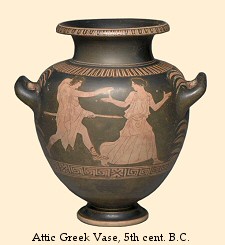 Regarding religious practices, there are clear indications that in some pagan religious observances it was the custom for women to take part with their heads uncovered. The cult of the goddess Demeter involved certain rites called the Eleusinian mysteries. A depiction of the Eleusinian mysteries on the Ninnion Tablet (figure 11, from the fourth century b.c.) in the National Archaeological Museum of Athens shows women wearing only tiaras or leaf chaplets in their hair. In the Rule of the Andanian Mysteries it is stipulated that the initiates "are all to be wreathed with laurel" and that none of the women are to wear a "hair band, or braided hair." (See the text of the rules concerning clothing on the page, Ritual Clothing in the Andanian Mystery Cult). In the worship of Dionysus, the female celebrants known as maenads not only came with uncovered heads but also let down their hair and danced in the public processions. Many ancient paintings show women presenting offerings at altars—probably as priestesses—without headcoverings (figure 12). The amount and the variety of this pictorial evidence makes it virtually certain that, in cultic contexts at least, Greek women did not always cover their heads in public.
Regarding religious practices, there are clear indications that in some pagan religious observances it was the custom for women to take part with their heads uncovered. The cult of the goddess Demeter involved certain rites called the Eleusinian mysteries. A depiction of the Eleusinian mysteries on the Ninnion Tablet (figure 11, from the fourth century b.c.) in the National Archaeological Museum of Athens shows women wearing only tiaras or leaf chaplets in their hair. In the Rule of the Andanian Mysteries it is stipulated that the initiates "are all to be wreathed with laurel" and that none of the women are to wear a "hair band, or braided hair." (See the text of the rules concerning clothing on the page, Ritual Clothing in the Andanian Mystery Cult). In the worship of Dionysus, the female celebrants known as maenads not only came with uncovered heads but also let down their hair and danced in the public processions. Many ancient paintings show women presenting offerings at altars—probably as priestesses—without headcoverings (figure 12). The amount and the variety of this pictorial evidence makes it virtually certain that, in cultic contexts at least, Greek women did not always cover their heads in public.
Roman Headcovering Customs

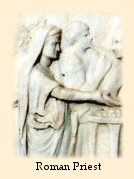
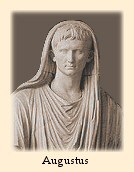
It is known that Roman priests covered their heads in religious ceremonies (figure 13). Some ancient statues of Caesar Augustus show him with a covered head (figure 14) because he was the Pontifex Maximus of Rome, and because he was interested in promoting the "traditional values" of the Romans, for political reasons. (6) Because Corinth was a Roman colony, some scholars have recently suggested that the Apostle Paul is referring to this Roman custom in 1 Corinthians 11:4. Presumably Roman citizens in Corinth would have observed their Roman customs when worshipping Roman gods. But it seems rather far-fetched to think that Greek Christians in Corinth would have imitated this custom of Roman priests. Even among the Romans, not all gods were worshipped with covered heads.
In connection with religion, there is an interesting passage in Tertullian's On the Pallium which indicates that there were a number of different customs of dress associated with different cults. While recommending the old-fashioned pallium to Carthaginians he ridicules the novelties introduced by exotic cults, saying, "for the sake of an all-white dress, and the distinction of a fillet, and the privilege of a helmet, some are initiated into the mysteries of Ceres; while, on account of an opposite hankering after sombre raiment, and a gloomy woollen covering upon the head, others run mad in Bellona's temple; while the attraction of surrounding themselves with a tunic more broadly striped with purple, and casting over their shoulders a cloak of Galatian scarlet, commends Saturn to the affections of others." (7) The cult of Isis, which was imported from Egypt during the time of Augustus, and was especially popular among women, featured ceremonies in which priests covered their heads but priestesses did not (figure 31).
The virgin priestesses of Vesta — called Vestal virgins — wore a special headcovering called a suffibulum (figure 15). This was a square piece of cloth that covered only the head (and perhaps the shoulders). On Roman coins of the first century the civic virtue of pietas, "piety," is personified as a woman with such a headcovering (figure 16), and another headcovering like it may be seen on ancient representations of Christian women carved into the walls of the Roman catacombs (figure 17). Another similar headcovering was the bridal veil (figure 18, discussed below). The suffibulum and bridal veil are thought to be ceremonial relics of the headcovering commonly worn by Roman women in very ancient times, called the ricinium — a shawl which covered only the head and shoulders. It seems that the ricinium fell into disuse when Roman women began to wear the palla. Another personification on Roman coins was pudicitia, "modesty" or "chastity," portrayed as a goddess covering her head with a palla. (8) These coins of the Empire celebrated the old Republican virtues. However, the other side of the coins often bore portraits of honorable ladies of Caesar's house—with their heads uncovered (figure 19).
Concerning ordinary Roman women of the first century, Plutarch in one place implies that it was "more usual for women to go forth in public with their heads covered." (9) But it is unclear to what extent Plutarch's "more usual" indicates a custom strictly adhered to. We do know that in the first century Roman society was undergoing changes, in a direction which can only be called morally dissolute. Ovid (43 b.c.–a.d. 17), in the generation preceding Paul, provides an impressive testimony to the sad state of Roman morals in his book Ars Amatoria (The Art of Love), with much explicit discussion of female dress, hairstyles and cosmetics. His advice to ladies concerning hairstyles and wigs would be pointless if the ladies went out with their heads covered. If Ovid's representation of Roman society is at all accurate, (10) it is hard to believe that there was any strict observance of headcovering customs in daily life. (Likewise the Apostle Paul's remark about braided hair in 1 Timothy 2:9 implies that in his experience women prided themselves on elaborate hairstyles, which is impossible with a headcovering.) Regarding the customs observed by the middle class, we note that it is not unusual to see merchant women portrayed without headcoverings in ancient Roman art (see figures 28, 29, 30). At about a.d. 200, Tertullian in Carthage (a Roman colony, like Corinth) wrote, "some, with their turbans and woollen bands, do not veil their head, but bind it up; protected, indeed, in front, but, where the head properly lies, bare. Others are to a certain extent covered over the region of the brain with linen coifs of small dimensions ... and not reaching quite to the ears" (On the Veiling of Virgins, chap. 17). So there are a number of independent sources which pretty clearly indicate that Roman women did not always cover their heads in public.
The Romans had a special headcovering custom for brides, as we do today. The bridal veil was a piece of cloth called a flammeum (lit. "flame-colored"), because it was dyed bright orange, and it was draped over the bride's head without covering her face (figure 20). Recently some biblical expositors have asserted that in Rome a married woman would always keep her head covered as a sign that she was married, but this assertion is not very well supported by ancient sources. The "veiling of the bride" spoken of in ancient sources pertains only to the wedding ceremony, not to a change of ordinary clothing.
There was one garment, however, that did have marital significance among the Romans. It was a sleeveless robe called a stola, worn over the tunica (figure 21). Traditionally, married women were expected to wear this extra layer of clothing in public. But in the first century this custom was apparently losing its force. Married women began to appear in public without the stola, and this gave rise to some complaints from conservative-minded Romans. There was some discussion about it in the Roman Senate, and severe legal steps were taken so as to compel married women to wear the stola, but it does not seem to have had the desired effect. At the end of the second century Tertullian makes reference to the ineffective decrees in Rome, where women had "abjured the stole," among other things, that they may go about "more openly" (On the Pallium, chapter 4). He declares that in Rome he sees "no distinction left in dress between matrons and harlots" (Apology for the Christians, chapter 6).
So much for Rome and its customs of dress. There is plenty of evidence that it was more usual for women to cover their heads, as Plutarch implies, but the ancient sources give us little reason to think that in the first century a respectable Roman woman would never appear in public with her head uncovered. The censorious remarks of Tertullian, which are connected with his Christian critique of pagan society, would probably have been dismissed as curmudgeonly by most people in Rome.
Jewish Customs
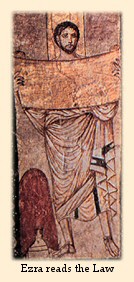 As indicated above, many of the Jews of the first century were Hellenized, having adopted many of the customs of the Greeks. But for the most part, Jews were interested in maintaining their own ethnic identity wherever they lived. They held to Jewish customs which set them apart from their Gentile neighbors. God had said:
As indicated above, many of the Jews of the first century were Hellenized, having adopted many of the customs of the Greeks. But for the most part, Jews were interested in maintaining their own ethnic identity wherever they lived. They held to Jewish customs which set them apart from their Gentile neighbors. God had said:
After the doings of the land of Egypt, wherein ye dwelt, shall ye not do: and after the doings of the land of Canaan, whither I bring you, shall ye not do: neither shall ye walk in their ordinances. (Leviticus 18:3. cf. also Deuteronomy 12:29-32 and 2 Kings 17:13-15.)
This principle extended even to clothing, as in the prophet Zephaniah:
The LORD has prepared a sacrifice and consecrated his guests ... and on the day of the LORD's sacrifice, I will punish ... all who array themselves in foreign attire. (Zephaniah 1:8)
The Lord had given a certain commandment to Moses regarding clothing, with an explanation for its reason:
Speak to the people of Israel, and tell them to make tassels on the corners of their garments throughout their generations, and to put a cord of blue on the tassel of each corner. And it shall be a tassel for you to look at and remember all the commandments of the LORD, to do them, not to follow after your own heart and your own eyes, which you are inclined to whore after. (Numbers 15:38-39. See also Deuteronomy 22:12, You shall make yourself tassels on the four corners of the garment with which you cover yourself.)
Therefore in ancient times all Jews wore such tassels on the corners of their upper garments (i.e. upon the four corners of the himation), as a reminder to themselves that they were God's people, and under His law. As Matthew Henry explains further:
The Jews being a peculiar people, they were thus distinguished from their neighbours in their dress, as well as in their diet, and taught by such little instances of singularity not to be conformed to the way of the heathen in greater things. Thus likewise they proclaimed themselves Jews wherever they were, as those that were not ashamed of God and his law. Our Saviour, being made under the law, wore these fringes; hence we read of the hem or border, of his garment (Matt. ix. 20).
 Regarding headcoverings, some biblical commentators in the past maintained that the custom observed in medieval times, in which Jewish men wore prayer shawls on their heads (figure 22), prevailed even in the first century, so that Paul's instruction regarding the men is opposed to the Jewish practice of his times. But this is not likely to be correct. Most scholars believe that the prayer shawl is a later custom which came into general use among Jews during the third century. (11) In the first century a Jewish man would often wear something on his head, for practical reasons (protection from the hot sun or from cold wind), but there was apparently no cultural expectation that he should cover or uncover his head at specific times. If Paul's rule regarding men covering their heads differs from Jewish custom, it would be in the direction of prohibiting something which was a matter of indifference among the Jews.
Regarding headcoverings, some biblical commentators in the past maintained that the custom observed in medieval times, in which Jewish men wore prayer shawls on their heads (figure 22), prevailed even in the first century, so that Paul's instruction regarding the men is opposed to the Jewish practice of his times. But this is not likely to be correct. Most scholars believe that the prayer shawl is a later custom which came into general use among Jews during the third century. (11) In the first century a Jewish man would often wear something on his head, for practical reasons (protection from the hot sun or from cold wind), but there was apparently no cultural expectation that he should cover or uncover his head at specific times. If Paul's rule regarding men covering their heads differs from Jewish custom, it would be in the direction of prohibiting something which was a matter of indifference among the Jews.
As for Jewish women, there is clear evidence that in the first century they covered their heads not only for prayer but whenever they were outside of their own home. It is said that some Jewish women kept themselves covered at all times. In public, they not only covered their heads, but the lower part of their faces as well. For the women this was a matter of morals, and a religious duty, not merely a matter of style or convenience. Joachim Jeremias describes the Jewish custom.
Eastern women take no part in public life. This was true of Judaism in the time of Jesus, in all cases where Jewish families faithfully observed the Law. When the Jewess of Jerusalem left her house, her face was hidden by an arrangement of two head veils, a head-band on the forehead with bands to the chin, and a hairnet with ribbons and knots, so that her features could not be recognized. It was said that once, for example, a chief priest in Jerusalem did not recognize his own mother when he had to carry out against her the prescribed process for a woman suspected of adultery. Any woman who went out without this headdress, i.e., without her face being hidden, committed such an offence against good taste that her husband had the right—and indeed the duty—to put her away from him, and was under no obligation to pay the sum of money to which, on divorce, the wife had a right by virtue of the marriage contract. There were even women so strict that they did not once uncover their head in the house, women like Qimhit, who, it was said, saw seven sons admitted to the high priesthood, which was regarded as divine reward for her extreme propriety: 'May it [this and that] befall me if the beams of my house have ever seen the hair of my head.' Only in her wedding procession was a bride seen with uncovered head, and then only if she were a virgin, not a widow. (12)
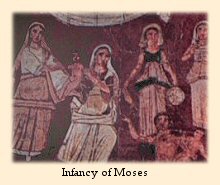 Philo of Alexandria (who lived from 20 b.c. to a.d. 50) in his treatise The Special Laws gives an interesting comment about the significance of the Jewish woman's headcovering. Regarding the procedure followed by priests who examined women accused of adultery (cf. Numbers 5:18) he writes, "And the priest shall take the barley and offer it to the woman, and shall take away from her the head-dress on her head, that she may be judged with her head bare, and deprived of the symbol of modesty, which all those women are accustomed to wear who are completely blameless." (13) The Greek word translated "modesty" here is αιδους, the genitive of αιδως (aidos), for which we have no exact equivalent in modern English. It denotes an attitude of humility and a capacity to feel shame, in a good sense, as opposed to shamelessness or impudence. In the writings of ancient moralists this quality of αιδως (or its Latin equivalent verecundia) was often mentioned as being one of the most important feminine virtues. The same word is used by Paul in his instruction concerning women's clothing in 1 Timothy 2:9, where it is translated "shamefastness" in the KJV. But it should not be taken for granted that Jews in general attached any such definite symbolical meaning to the headcovering. Probably most Jews did not feel any need for a symbolical interpretation of the custom, and would have given it no more thought than they gave to any other article of dress.
Philo of Alexandria (who lived from 20 b.c. to a.d. 50) in his treatise The Special Laws gives an interesting comment about the significance of the Jewish woman's headcovering. Regarding the procedure followed by priests who examined women accused of adultery (cf. Numbers 5:18) he writes, "And the priest shall take the barley and offer it to the woman, and shall take away from her the head-dress on her head, that she may be judged with her head bare, and deprived of the symbol of modesty, which all those women are accustomed to wear who are completely blameless." (13) The Greek word translated "modesty" here is αιδους, the genitive of αιδως (aidos), for which we have no exact equivalent in modern English. It denotes an attitude of humility and a capacity to feel shame, in a good sense, as opposed to shamelessness or impudence. In the writings of ancient moralists this quality of αιδως (or its Latin equivalent verecundia) was often mentioned as being one of the most important feminine virtues. The same word is used by Paul in his instruction concerning women's clothing in 1 Timothy 2:9, where it is translated "shamefastness" in the KJV. But it should not be taken for granted that Jews in general attached any such definite symbolical meaning to the headcovering. Probably most Jews did not feel any need for a symbolical interpretation of the custom, and would have given it no more thought than they gave to any other article of dress.
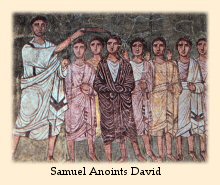 Artistic evidence of the Jewish customs is lacking because the Jews—like the Muslims today—were adverse to the visual arts. Pictures were discouraged because of the commandment against the making of idols. (14) But there is some ancient pictorial evidence. Most notable are the frescos on the walls of an ancient Jewish synagogue in Dura Europos, Syria (dating from the middle of the third century), which portray various biblical characters, presumably in the clothing which was familiar to the Jews who used this synagogue. Here, evidently, was a congregation of deeply Hellenized Jews. Some of the men in the frescos are portrayed clean-shaven, and they do not wear tassels on their garments. (15) The very fact that this synagogue was decorated with pictures indicates that it was the home of an unusually 'liberal' congregation. But for what it is worth, we may note that the men are bare-headed (figures 23 and 24) and the women wear headcoverings (figure 25) in these frescos. This is what we would expect to see in Syria at that time, on the basis of the literary evidence.
Artistic evidence of the Jewish customs is lacking because the Jews—like the Muslims today—were adverse to the visual arts. Pictures were discouraged because of the commandment against the making of idols. (14) But there is some ancient pictorial evidence. Most notable are the frescos on the walls of an ancient Jewish synagogue in Dura Europos, Syria (dating from the middle of the third century), which portray various biblical characters, presumably in the clothing which was familiar to the Jews who used this synagogue. Here, evidently, was a congregation of deeply Hellenized Jews. Some of the men in the frescos are portrayed clean-shaven, and they do not wear tassels on their garments. (15) The very fact that this synagogue was decorated with pictures indicates that it was the home of an unusually 'liberal' congregation. But for what it is worth, we may note that the men are bare-headed (figures 23 and 24) and the women wear headcoverings (figure 25) in these frescos. This is what we would expect to see in Syria at that time, on the basis of the literary evidence.
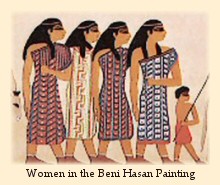 There is no need to suppose that this custom was observed by all peoples of the Middle East from earliest times. One wall-painting in the tomb of an Egyptian ruler, known as the The Beni Hasan painting (figure 26), shows a group of nomadic traders from the region of Syria and Canaan arriving in Egypt with their women and children, around the year 1890 b.c. (16) This was in the days of Abraham. In this painting the women are depicted wearing headbands, without headcoverings. We also note that although the tunics of the women are longer than those of the men in the painting, they are rather close-fitting, and on three of the women they leave one shoulder bare. It may be that the clothing of the women in this painting is not entirely realistic, and follows certain artistic conventions; but it may also be taken as an indication that in those days at least some women from the region of Palestine did not ordinarily cover their heads, or observe other customs of feminine dress which seem to have become universal by the beginning of the Christian era. In any case, the usual Eastern customs of modest dress probably originated in urban settings, where standards and distinctions of dress have always tended to be more elaborate. Perhaps these customs never had much importance outside of the towns.
There is no need to suppose that this custom was observed by all peoples of the Middle East from earliest times. One wall-painting in the tomb of an Egyptian ruler, known as the The Beni Hasan painting (figure 26), shows a group of nomadic traders from the region of Syria and Canaan arriving in Egypt with their women and children, around the year 1890 b.c. (16) This was in the days of Abraham. In this painting the women are depicted wearing headbands, without headcoverings. We also note that although the tunics of the women are longer than those of the men in the painting, they are rather close-fitting, and on three of the women they leave one shoulder bare. It may be that the clothing of the women in this painting is not entirely realistic, and follows certain artistic conventions; but it may also be taken as an indication that in those days at least some women from the region of Palestine did not ordinarily cover their heads, or observe other customs of feminine dress which seem to have become universal by the beginning of the Christian era. In any case, the usual Eastern customs of modest dress probably originated in urban settings, where standards and distinctions of dress have always tended to be more elaborate. Perhaps these customs never had much importance outside of the towns.
Some Conclusions regarding the Customs of the Time
From the discussion of customs given above, it may be seen that interpreting 1 Corinthians 11:2-16 in the light of customs of the day is no simple matter. Aside from our uncertainties about Jewish, Greek and Roman customs, in Corinth we have these three cultures coming together in one place, at a time when the Greek and Roman traditions were losing their force. In fact this cultural ferment and dissolution is one of the things that set the stage for Paul's successful mission in Greece. The old gods and the old ways were dying, and the Greek world was wide open to change.
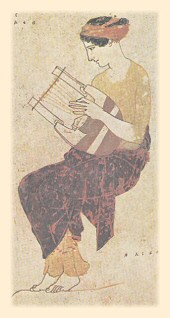 It may not even be helpful to ask about a prevailing custom in Corinth. The question presupposes that there was a prevailing custom. But Corinth was a large and diverse cosmopolitan city, and it is probably more useful to think of multiple customs and fashions rather than a single custom in this context. Corinth was not the kind of social setting in which we would expect the stability and uniformity of a traditional culture. We might compare it to a modern metropolis, such as New York City, in which one might see on the same street a significant variety of people dressed according to ethnic customs or styles of the day. Probably differences of custom and style were taken in stride, and aroused little notice. And it is entirely possible that the current fashion of some segments of the Corinthian population was to go bareheaded. Corinthian women may have been less inclined to wear a headcovering simply because it was not prescribed by custom in Corinth. One scholar has recently suggested the traditional custom of dress in Corinth was to cover the head in public, but that this Greek custom was breaking down in the first century. Bruce W. Winter has shown that in patrician Roman society, at least, many women of the first century were departing from the traditional roles and customs of wives, and this involved symbolical departures from traditional decorum in dress. Corinth, as a Roman colony, would likely have been affected by this movement as women there emulated the behavior of the high-class women in Rome. (17) In this case, Paul would be urging the Corinthian women to desist from imitating the avant-garde "fashion leaders" of Roman society and return to the traditional attire which was formerly expected of women in Corinth.
It may not even be helpful to ask about a prevailing custom in Corinth. The question presupposes that there was a prevailing custom. But Corinth was a large and diverse cosmopolitan city, and it is probably more useful to think of multiple customs and fashions rather than a single custom in this context. Corinth was not the kind of social setting in which we would expect the stability and uniformity of a traditional culture. We might compare it to a modern metropolis, such as New York City, in which one might see on the same street a significant variety of people dressed according to ethnic customs or styles of the day. Probably differences of custom and style were taken in stride, and aroused little notice. And it is entirely possible that the current fashion of some segments of the Corinthian population was to go bareheaded. Corinthian women may have been less inclined to wear a headcovering simply because it was not prescribed by custom in Corinth. One scholar has recently suggested the traditional custom of dress in Corinth was to cover the head in public, but that this Greek custom was breaking down in the first century. Bruce W. Winter has shown that in patrician Roman society, at least, many women of the first century were departing from the traditional roles and customs of wives, and this involved symbolical departures from traditional decorum in dress. Corinth, as a Roman colony, would likely have been affected by this movement as women there emulated the behavior of the high-class women in Rome. (17) In this case, Paul would be urging the Corinthian women to desist from imitating the avant-garde "fashion leaders" of Roman society and return to the traditional attire which was formerly expected of women in Corinth.
Some scholars think that Paul's insistence upon the headcovering in his Greek churches is really an attempt to introduce or enforce a Jewish custom. (18) Because there was nothing especially Jewish about a woman going about with her head covered, these scholars usually maintain that Paul wants the Corinthian women to observe the face-veiling customs described by Jeremias above. But this is very doubtful, because there is nothing in the passage which suggests it, and the use of headcoverings by women in daily life was common enough throughout the ancient world that we would expect Paul to make his meaning clear if he were requiring not only this but also the face-veiling. We would expect him to use a word or expression for the face-covering or veil (καλυμμα), at least, but that is not the case here. Instead, Paul uses only a very general word for "covered," κατακαλυπτω. This word, with its prefix κατα, does however mean thoroughly covered. It cannot refer to ornamental or token headpieces, or to the headbands ordinarily used by Greek women.
Even if it could be established that in Corinth and in other Greek cities of the first century women were expected to cover their heads in public, we need to ask further concerning the customs at worship. As noted above, in some religious contexts Greek women did participate in religious exercises with their heads uncovered. This may have something to do with our passage, because Paul's discussion specifically focuses on attire while praying and prophesying. Did the Corinthian women want to remove their headcoverings while praying or prophesying because this corresponded to the customs of the pagan mystery cults, in which women uncovered their heads? Perhaps they were tempted to do this. The likelihood of it is increased by the fact that there are many points of contact between the practices of the mystery cults and the issues Paul deals with in his letters to the Corinthians, and charismatic women in particular may have been vulnerable to this influence because of the focus upon emotional exaltation in the mystery cults. (19)
Regarding Paul's statement about men covering their heads for prayer, some caution is in order. This statement may have nothing much to do with customs of the time. It may be, as Lenski says, that Paul talks about a man covering his head "not because some man in Corinth is liable to do such a thing, but in order to bring out the contrast with the woman." (20) In this passage his main interest is in the headcovering of women, and not of men.
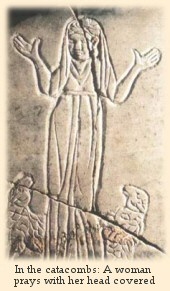 A further difficulty with all the "cultural accomodation" explanations for Paul's headcovering rule is that Paul himself offers no explanations for it along those lines. He gives other reasons. It should be noted that Paul gives no indication in any of his Epistles that he would recommend mere conformity to Greek customs as an acceptable principle of conduct for Christians. (The case is otherwise with Jewish customs, which he sometimes urges Gentiles to respect, as in 10:23–11:1). It would seem best to take his explanations at face value rather than theorize about ulterior reasons related to Greek cultural practices. In verse 16 Paul says that the woman's headcovering is a practice which pertains to the churches of God, and it may be that the use of the headcovering in the churches did not correspond exactly to either the Jewish or Greek customs of the day. (21) It probably is true that this rule in the churches was originally a Christian modification of the Jewish custom, in which the custom was somewhat liberalized. That is, Christian women were expected to wear headcoverings at religious gatherings (probably also whenever in public) without the face-veiling, even in those places (like Corinth) where the pagan society did not currently require a woman to wear any headcovering. In any case, "cultural expectations" in Corinth were probably much more complex and fluid than some scholars think they were, and I do not think that the ambiguous information and speculations about Greek customs provide us with any sure basis for a general interpretation of this passage.
A further difficulty with all the "cultural accomodation" explanations for Paul's headcovering rule is that Paul himself offers no explanations for it along those lines. He gives other reasons. It should be noted that Paul gives no indication in any of his Epistles that he would recommend mere conformity to Greek customs as an acceptable principle of conduct for Christians. (The case is otherwise with Jewish customs, which he sometimes urges Gentiles to respect, as in 10:23–11:1). It would seem best to take his explanations at face value rather than theorize about ulterior reasons related to Greek cultural practices. In verse 16 Paul says that the woman's headcovering is a practice which pertains to the churches of God, and it may be that the use of the headcovering in the churches did not correspond exactly to either the Jewish or Greek customs of the day. (21) It probably is true that this rule in the churches was originally a Christian modification of the Jewish custom, in which the custom was somewhat liberalized. That is, Christian women were expected to wear headcoverings at religious gatherings (probably also whenever in public) without the face-veiling, even in those places (like Corinth) where the pagan society did not currently require a woman to wear any headcovering. In any case, "cultural expectations" in Corinth were probably much more complex and fluid than some scholars think they were, and I do not think that the ambiguous information and speculations about Greek customs provide us with any sure basis for a general interpretation of this passage.
Works Cited in the Notes
Angus. S. Angus, The Mystery-Religions and Christianity (New York: Charles Scribner's Sons, 1925).
Brown. Colin Brown, "Head," in The New International Dictionary of New Testament Theology, vol 2 (Grand Rapids: Zondervan, 1976), pp. 156-63.
Clark. Stephen B. Clark, Man and Woman in Christ: An Examination of the Roles of Men and Women in Light of Scripture and the Social Sciences (Ann Arbor, Michigan: Servant Books, 1980).
Conzelmann. Hans Conzelmann, 1 Corinthians, in the Hermeneia commentary series (Philadelphia: Fortress Press, 1975), translated from the German Der erste Brief an die Korinther, 1st edition (Göttingen: Vandenhoeck & Ruprecht, 1969).
Dio Chrysostom, Orationes, in Dio Chrysostom, with an English Translation by J. W. Cohoon and H. Lamar Crosby. 5 volumes. Loeb Classical Library (Cambridge, Massachusetts: Harvard University Press, 1940-46).
Dionysius of Halicarnassus. Earnest Cary, ed., The Roman Antiquities of Dionysius of Halicarnassus. Loeb Classical Library (Cambridge: Harvard University Press, 1963).
Epstein. Louis M. Epstein, Sex Laws and Customs in Judaism (New York: KTAV, 1967).
Fee. Gordon D. Fee, The First Epistle to the Corinthians (Grand Rapids: Eerdmans, 1987).
Findlay. G.G. Findlay, The First Epistle of Paul to the Corinthians, in The Expositor's Greek Testament (London: Hodder & Stoughton, 1900).
Gill. D.W.J. Gill, "The Importance of Roman Portraiture for Head-coverings in 1 Corinthians 11:2-16," Tyndale Bulletin 41/2 (1990), pp. 245-60.
Ginzberg. Louis Ginzberg, The Legends of the Jews. 7 volumes. (Philadelphia: Jewish Publication Society, 1909-1938).
Hodge. Charles Hodge, An Exposition of the First Epistle to the Corinthians (New York: R. Carter, 1857).
Jeremias. Joachim Jeremias, Jerusalem in the Time of Jesus (Philadelphia: Fortress Press, 1969).
Joyce. Thomas A. Joyce, "Costume," in the Encyclopædia Britannica 11th edition, vol. 7 (New York: Encyclopædia Britannica Co., 1910), pp. 224-26.
Käsemann. Ernst Käsemann, New Testament Questions of Today, translated by W. J. Montague (Philadelphia: Fortress Press, 1969).
Kittel. Gerhard Kittel, "Images of God and Men in Judaism and Christianity," in the Theological Dictionary of the New Testament, vol. 2 (Grand Rapids: Eerdmans, 1964), pp. 383-388.
Lenski. R.C.H. Lenski, The Interpretation of St. Paul's First and Second Epistles to the Corinthians (Minneapolis: Augsburg Publishing House, 1963. Reprinted from the original edition of 1937).
Lightfoot. John Lightfoot, Horæ Hebraicæ et Talmudicæ: Hebrew and Talmudical exercitations upon the Gospels, the Acts, some chapters of St. Paul's Epistle to the Romans, and the First epistle to the Corinthians. A new edition by the Rev. Robert Gandell. 4 vols. (Oxford: Oxford University Press, 1859). Originally written in Latin and published at intervals between 1658 and 1674. Gandell's English edition of 1859 has been reprinted under the title A Commentary on the New Testament from the Talmud and Hebraica by Hendrickson Publishers in Peabody Massachusetts, 1989.
Llewellyn-Jones, Aphrodite's Tortoise. Lloyd Llewellyn-Jones, Aphrodite's Tortoise: The Veiled Woman of Ancient Greece (Classical Press of Wales, 2002).
Llewellyn-Jones, Women's Dress. Lloyd Llewellyn-Jones, ed., Women's Dress in the Ancient Greek World (Gerald Duckworth & Co., 2002).
Millgram. Abraham Millgram, Jewish Worship (Jewish Publication Society, 1971).
Neusner. Jacob Neusner, Rabbinic Literature and the New Testament (Valley Forge, PA: Trinity Press, 1994).
Oepke. Albrecht Oepke, "κατακαλυπτω" in Kittel's Theological Dictionary of the New Testament, vol. III, pp. 561-3.
Philo of Alexandria, The Works of Philo, translated by C.D. Yonge. New Updated Edition, edited by David M. Scholer (Peabody, Mass: Hendrickson, 1993). The Greek text of Philo's treatise The Special Laws is found in Leopold Cohn, ed, Philonis Alexandrini Opera quae Supersunt, vol. 5 (Berlin: Reimer, 1906).
Plutarch, Plutarch's Moralia, in Fifteen Volumes, with an English Translation by Frank Cole Babbitt. Loeb Classical Library series (Cambridge, Mass: Harvard University Press, 1936).
Pritchard, 1954. James B. Pritchard, ed., The Ancient Near East in Pictures Relating to the Old Testament. (Princeton, New Jersey: Princeton University Press, 1954).
Pritchard, 1955. James B. Pritchard, ed., Ancient Near Eastern Texts Relating to the Old Testament. 2nd ed. (Princeton, New Jersey: Princeton University Press, 1955).
Robertson. A.T. Robertson, Word Pictures in the New Testament 6 vols. (Nashville: Broadman Press, 1930-1933).
Rubens. Alfred Rubens, A History of Jewish Costume (London: Weidenfeld and Nicolson, 1973).
Sebasta. Judith Lynn Sebasta, "Women's Costume and Feminine Civic Morality in Augustan Rome," Gender and History 9/3 (1997), pp. 529-541. Reprinted in M. Wyke, ed., Gender and the Body in the Ancient Mediterranean (Oxford, 1998), pp. 81-104.
Strack-Billerbeck. Hermann Strack and Paul Billerbeck, Kommentar zum neuen Testament aus Talmud und Midrasch (München, 1961).
Tertullian, On the Veiling of Virgins. "On the Veiling of Virgins," translated by S. Thelwall, in The Ante-Nicene Fathers, volume iv, ed. A. Roberts and J. Donaldson (Edinburgh, 1885).
Tertullian, On the Pallium. "On the Pallium," translated by S. Thelwall, in The Ante-Nicene Fathers, volume iv, ed. A. Roberts and J. Donaldson (Edinburgh, 1885).
Tertullian, Against the Valentinians. M.T. Riley, ed., Tertulliani Adversus Valentinianos (Diss. Stanford University, 1971); Franz Oehler, ed., Quinti Septimii Florentis Tertulliani quae supersunt omnia, edidit Franciscus Oehler (Lipsiae: T. O. Weigel, 1851-1854). 3 vols.
Thompson. Cynthia L. Thompson, "Hairstyles, Headcoverings, and St. Paul: Portraits from Roman Corinth," in Biblical Archeologist, June 1988, pp. 99-115.
Winter, 2001. Bruce W. Winter, After Paul Left Corinth: The Influence of Secular Ethics and Social Change (Grand Rapids: Eerdmans, 2001).
Winter, 2003. Bruce W. Winter, Roman Wives, Roman Widows: The Appearance of New Women and the Pauline Communities (Grand Rapids: Eerdmans, 2003).
M. Y., "Head, Covering of," in the Encyclopaedia Judaica, Vol. 8 (Jerusalem: Keter Publishing House, 1971).
Zinserling. Verena Zinserling, Women in Greece and Rome (New York: Abner Schram, 1972).
NOTES
1. In the first century, trousers were associated with the Northern barbarians, who doubtless invented them for greater warmth in the cold climate. Thomas A. Joyce explains that "one of the points about the northern barbarians which struck the ancient Greeks and Romans most forcibly was the fact that they wore trousers. Amongst the most northerly races the latter garb is worn by both sexes alike; farther south by the men, the women retaining the tropical form; farther south still the latter reigns supreme ... The retention by women in Europe of the tropical garb can be explained by the fact that her sphere has been mainly confined to the house, and her life has been less active than that of man; consequently the adoption of the arctic dress has been in her case less necessary." ("Costume," in the Encyclopedia Britannica, 11th edition, p. 225).
2. The chiton was merely two pieces of linen sewn together in a cylinder, with the top edge of the cylinder stitched or pinned together at the shoulders. A girdle of cloth was then tied around it to hold it close to the body. The length was adjusted by pulling some of the fabric up and over the girdle. There was another garment known as the peplos associated with the Doric Greeks (the Spartans were Dorians). The peplos was a single piece of wool wrapped into a cylinder, folded over at the top, and fastened at the shoulders. The overfold (called the apoptygma) hung down to the waist like a cape. Traditionally the peplos was not sewn together, but left open on the right side. Only the girdle kept the garment together on the right. But the so-called "Attic" or "Corinthian" peplos was sewn together. There were several variations of the chiton (some with sleeves) and other garments also, which I do not mention here.
3. Many of the statements regarding Greek customs found in otherwise respectable commentaries reveal a surprising level of carelessness in the use of cultural background information. Unsupported speculations are often asserted as fact, and then repeated by other scholars. For example, G.G. Findlay, writing in The Expositor's Greek Testament (1900) states that "Amongst Greeks only the hetaerae [high-class prostitutes], so numerous in Corinth, went about unveiled" (vol. II, p. 872), but he gives no historical source for this assertion. This statement is quoted by A.T. Robertson in his Word Pictures in the New Testament (1933) without any indication of its being questionable (vol. IV, pp. l59-l60), and from there it is quoted in several more recent books. But there is no historical basis for the assertion, and it is contradicted by some evidence. For ancient depictions of Greek women in public and in pagan worship services without headcoverings see Verena Zinserling, Women in Greece and Rome (New York: Abner Schram, 1972). Zinserling also gives illustrations of Greek hetaerae wearing head-dresses which cover the hair.
Some commentators who maintain that Paul is advising conformity to Greek customs simply fail to make any distinction between oriental and Greek society. An example of this is in Charles Hodge's commentary (1857), in which he writes, "A costume which is proper in one country, would be indecorous in another. The principle insisted upon in this paragraph is, that women should conform in matters of dress to all those usages which the public sentiment of the community in which they live demands. The veil in all eastern countries was and to a great extent still is, the symbol of modesty and subjection. For a woman, therefore, in Corinth to discard the veil was to renounce her claim to modesty and to refuse to recognize her subordination to her husband." (p. 204). But clearly, a prevailing custom of "eastern countries" cannot be assumed to be in force in Corinth, or in any other Greek city, for that matter.
A further problem, which renders much of what has been written on this subject almost worthless, is the failure of many commentators to make any distinction between face-veiling and headcovering in the ancient sources. Oepke writes as if he thought Tertullian had in mind face-veiling when he used the words velum and velo, but this cannot be right. The context must be carefully examined to determine what an ancient writer is referring to with various words for veils and coverings.
One also sees some really inexcusable misrepresentations of the ancient evidence, as in Conzelmann's commentary, where he states that "Tertullian (Virg. vel. 8.8) says the Corinthian woman is striking for the fact that she wears a veil." (Cf. note 40 on page 185 of the English edition.) Conzelmann offers this citation as support for his statement that there is evidence for various Greek customs of the first century, which is true, but Tertullian's comments regarding the Corinthian women have no bearing at all on matters of cultural background, because he merely describes the custom observed in the churches of Corinth, in accordance with their understanding of Paul's instructions in 1 Corinthians. This may be seen by anyone who takes the trouble to find the citation in Tertullian's treatise. ("So, too, did the Corinthians themselves understand him. In fact, at this day the Corinthians do veil their virgins. What the apostles taught, their disciples approve.") Yet those who do not take the trouble to find Tertullian's comments will certainly be misled by Conzelmann's satement into thinking that Tertullian's statement pertained to the custom observed by Corinthian women generally.
Another egregious misuse of Tertullian is in Cynthia Thompson's article "Hairstyles, Headcoverings, and St. Paul," in which she quotes a phrase from Tertullian's On the Veiling of Virgins. She says that with his words arbitrio permissa res erat in chapter 3 Tertullian acknowledged that in the churches "until close to his time the matter of women's wearing veils was left to free choice" (p. 112), and thus she supports her idea that in 1 Cor. 11:10 the phrase "a woman ought to have authority over her head" was taken to mean that Christian women had the right to decide for themselves whether or not they would wear a headcovering. Yet anyone who will consult Tertullian will immediately see that when he says, "the matter had been left to choice," he is talking about a difference of practice concerning the veiling of virgins, not women in general. One gets the impression that scholars are shopping for proof-texts for their theories rather than handling the ancient evidence with due care and integrity.
4. In a recent book by Lloyd Llewellyn-Jones, Aphrodite's Tortoise: The Veiled Woman of Ancient Greece (Classical Press of Wales, 2002), it is argued that Greek women frequently pulled this garment across the lower part of the face, as a way of veiling the face. See also the collection of articles edited by Llewellyn-Jones, Women's Dress in the Ancient Greek World (Gerald Duckworth & Co., 2002). But clearly the Greeks and Romans did not have such strict veiling customs as were practiced in the East.
5. Plutarch (a.d. 46-120) was a very popular Greek author. His "Sayings of Spatans" is part of the work called Moralia, in the Loeb edition (with English translation), vol. 3. The saying quoted here is on page 393.
6. Dionysius of Halicarnassus (first century b.c.) gives a legendary explanation for the Roman custom in his work, The Roman Antiquities. He writes: "They say that Aeneas, the son of Anchises and Venus, when he had landed in Italy, was intending to sacrifice to some one or other of the gods, and after praying was about to begin the sacrifice of the animal that had been prepared for the rite, when he caught sight of one of the Achaeans approaching at a distance -- either Ulysses, when he was about to consult the oracle near Lake Avernus, or Diomed, when he came as an ally to Daunus. And being vexed at the coincidence and wishing to avert as an evil omen the sight of an enemy that had appeared at the time of a sacrifice, he veiled himself and turned back; then, after the departure of the enemy, he washed his hands again and finished the sacrifice. When the sacrifices turned out rather favourably, he was pleased at the coincidence and observed the same practice on the occasion of every prayer; and his posterity keep this also as one of the customary observances in connexion with their sacrifices." (Book 12, chap.16.) This is typical of ancient explanations for customs. The custom is attributed to a legendary founder of the race, whose descendants quite naturally follow his example.
But apparently this explanation was not found sufficient by the more philosophically-minded, because we have some symbolical explanations offered by Plutarch. In the "Roman Questions" of his Moralia, Plutarch asks, "Why is it that when they worship the gods, they cover their heads, but when they meet any of their fellow-men worthy of honour, if they happen to have the toga over the head, they uncover?" He speculates that concealing the head is a way of "humbling themselves" before the gods, but that men of higher rank are saluted by uncovering the head "to avert from them the jealousy of the gods, that these men may not seem to demand the same honours as the gods." He notes that in the worship of Saturn, in which sacrifices are offered with the head uncovered, there is an exception, perhaps because "they cover the head before the heavenly deities, but they consider Saturn a god whose realm is beneath the earth." Another exception is the god called "Honor." He then poses a related question: "Why do sons cover their heads when they escort their parents to the grave, while daughters go with uncovered heads and hair unbound?" On this question he speculates, "Is it because fathers should be honoured as gods by their male offspring, but mourned as dead by their daughters, that custom has assigned to each sex its proper part and has produced a fitting result from both? Or is it that the unusual is proper in mourning, and it is more usual for women to go forth in public with their heads covered and men with their heads uncovered? So in Greece, whenever any misfortune comes, the women cut off their hair and the men let it grow, for it is usual for men to have their hair cut and for women to let it grow" (Loeb edition, vol. 4, p. 27). From this we may infer several things: Roman men usually went about uncovered, but covered their heads for worship of most of their gods. D.W.J. Gill, in his article "The Importance of Roman Portraiture for Head-coverings in 1 Corinthians 11:2-16," argues that this headcovering custom is confirmed by ancient statuary, in which the emperor Augustus is represented with his toga draped over his head, but he maintains that this custom was only for those taking a leading part in the rites. Men also covered their heads as a sign of mourning at family funerals. Roman women more often went about covered, but uncovered their heads as a sign of mourning at funerals. Observe that Plutarch says nothing about the headdress of Greek women, but mentions only the cutting of their hair.
Among New Testament commentators, Gordon Fee is perhaps the worst offender in his statements about the Roman headcovering customs. Although all of the above information is well-known to historians of ancient Roman society, Fee asserts that "there is almost no evidence (paintings, reliefs, statuary, etc.) that men in any of the cultures (Greek, Roman, Jew) covered their heads" (The First Epistle to the Corinthians, p. 507). This is true of the Greeks, but with regard to the Romans it is quite false. We can only suppose that Fee has not done any research on the subject, though he gives the appearance of having done research by mentioning in a footnote "two notable exceptions" in which Romans appear with headcoverings in a cultic setting, in the "painting from the Isis temple in Pompeii" (p. 507, n. 61). His idea that these two representations are "exceptions" in the mass of Roman evidence shows that he knows nothing about the subject, despite his scholarly affectations.
7. Ante-Nicene Fathers, American edition, vol. 4, p. 10.
8. We note also that in Tertullian's treatise Against the Valentinians he uses the words veneratio (reverence, respect, veneration), verecundia (bashfulness, shame), and officium (ceremonial action, sense of duty, deference) in connection with veiling. The Valentinians were a gnostic sect that flourished in the second and third centuries. In his account of their myths concerning a fallen goddess named Achamoth, Tertullian says she was "struck with the great pomp" of a superior god (named Soter) coming to her with his angelic entourage, and "immediately covered herself with a veil, moved at first with a dutiful feeling of veneration and bashfulness" (chap. xvi). The inclusion of this detail about Achamoth's veiling in Tertullian's source is probably due to some ritual use of the veil among the Valentinians, who identified themselves with Achamoth in their rite of initiation. See the Latin text in M.T. Riley, Tertulliani Adversus Valentinianos (Diss. Stanford University, 1971).
9. See note 6.
10. We must keep in mind that Ovid and other writers of the era describe the manners of the upper class. Thomas G. Tucker in his Life in the Roman World of Nero and St. Paul (London: Macmillan & Co., 1910) has a chapter on "The Women," in which he emphasizes that "our information is almost entirely restricted to the higher, or at least the wealthier, orders." Yet it seems likely that the privileged women described by Ovid and Juvenal set the tone for urban life in general. The virtuous and discreet wife of Pliny the Younger, as described by him in his letter to Calpurnia Hispulla (Letters, 4.19), is often mentioned as a counter-example. He writes, "When at any time I recite my works, she sits close at hand, concealed behind a curtain (in proximo discreta velo sedet), and greedily overhears my praises," which would seem to indicate that Roman women kept themselves away from some public contexts — but Ovid's remarks show that they were undoubtedly present at the Circus, and even Pliny's letter shows that women of good reputation were inclined to invade (however discretely) those literary gatherings where which were traditionally attended only by men.
11. This is the view held by nearly all historians today. In the first century it was a sign of grief or humility for a man to cover his head, except of course when there was some practical reason for it related to the weather. Among Jews the custom of covering the head for prayer did not arise till the third or fourth century of the Christian era. Some theorize that Jews adopted the yarmulke in a reaction against Christian customs. For example, the Jewish scholar Abraham Millgram, in his book Jewish Worship (Jewish Publication Society, 1971), writes, "As the persecutions of the Church increased, the Jewish aversion to everything Christian deepened. The uncovering of the head became associated with Church etiquette and therefore became repugnant. To worship or even to go about with an uncovered head was regarded as imitation of the Christians and an act of irreverence" (p. 351). See also the article "Head, Covering of," in the Encyclopedia Judaica, Vol. 8 (Jerusalem: Keter Publishing House, 1971), in which it is said that one Jewish sage declared that "since Christians generally pray bareheaded, the Jewish prohibition to do so was based on the biblical injunction not to imitate the heathen custom." (p. 5.) The assertion that the men covered their heads for prayer in New Testament times, often found in the older commentaries (such as John Lightfoot's Horæ Hebraicæ et Talmudicæ) was based entirely upon statements about headcoverings in the Talmudic tractates of late antiquity. But in the past hundred years scholars have become much more cautious about the use of rabbinic literature dating from the fourth century as a source of evidence for first-century practices. On the need for historical criticism of the Talmud see Jacob Neusner, Rabbinic Literature and the New Testament (Valley Forge, PA: Trinity Press, 1994). For the Talmudic parallels and a thorough discussion of the origin of the skullcap and prayer shawl (in German), see Hermann Strack and Paul Billerbeck, Kommentar zum neuen Testament aus Talmud und Midrasch (München, 1961), volume 3, pp. 423-437. On the world wide web see the page Jewish Dress by Rabbi Lawrence Rigal (South West Essex And Settlement Reform Synagogue in Ilford, Essex, England), which gives information from the study by Alfred Rubens, A History of Jewish Costume (London: Weidenfeld and Nicolson, 1973).
12. Joachim Jeremias, Jerusalem in the Time of Jesus (Philadelphia: Fortress Press, 1969), pp. 359-360. Of course the extreme propriety observed by Qimhit should not be seen as typical, and we may assume that Jewish women used headcoverings not in some legalistic spirit but simply as a matter of custom, and within the bounds of common sense. Jeremias goes on to say, "There is no indication that the custom of wrapping up the head was observed as strictly in the country as in the town." (p. 362) For more detailed discussion and references see Strack-Billerbeck, and Louis M. Epstein, Sex Laws and Customs in Judaism (New York: KTAV, 1967), pp. 36-41. It should also be noted that the custom was not confined to Jews. It may be described as an Eastern custom. Dio Chrysostom (a.d. 40-112) in one of the discourses preserved in his Orationes mentions that in the city of Tarsus in Asia Minor there was in his day a custom "still in force" as a remnant of the "orderliness and sobriety" of former days: "a convention regarding feminine attire, a convention which prescribes that women should be so arrayed and should so deport themselves when in the street that nobody could see any part of them, neither of the face nor of the rest of the body, and that they themselves might not see anything off the road." He adds that "they, like surveyors, can see more keenly with but one of their eyes" (Loeb edition, vol. 3., p. 319). The editors of the Loeb edition suggest in a footnote that "This prescription may have been due to the oriental element at Tarsus," by which they probably mean the Jews. From Dio Chrysostom's remarks it appears that the women of Tarsus generally veiled themselves by pulling a headcovering diagonally across the face, covering the nose, mouth, and one eye. There is good reason to think that an uncovered head was associated with prostitution in Assyria as early as the 15th century b.c. The Middle Assyrian Laws preserved on clay tablets from the time of Tiglath-pileser (12th century b.c.) contain a law requiring all Assyrian women to cover their heads in public (with "a shawl or a robe or a mantle"), with the exception of prostitutes, who are forbidden to cover their heads (see the text of the law in Pritchard, Ancient Near Eastern Texts, p. 183).
13. The Works of Philo, translated by C.D. Yonge. New Updated Edition, edited by David M. Scholer (Peabody, Mass: Hendrickson, 1993), p. 599. The Greek text, as edited by Leopold Cohn, is as follows: ο δε ιερευς λαβων προτεινετω τη γυναικι και τουπικρανον αφελων, ιν' επικρινηται γεγυμνωμενη τη κεφαλη, το της αιδους περιηρημενη συμβολον, ω ταις εις απαν αναιτιοις εθος χρησθαι (De Special. Legibus, Book III, paragraph 56). We observe that Philo, like the Apostle Paul, interprets the headcovering as a symbol. Louis Ginzberg gives a legendary Jewish explanation from later Rabbinic sources, such as the Bereshit Rabbah, in which a Rabbi asserts that shame for Eve's sin is the reason: "The very differences between the sexes in garb and social forms go back to the origin of man and woman for their reasons. Woman covers her hair in token of Eve's having brought sin into the world; she tries to hide her shame; and women precede men in a funeral cortege, because it was woman who brought death into the world. And the religious commands addressed to women alone are connected with the history of Eve." (The Legends of the Jews, vol. 1, p. 67; and see vol. 5, pp. 89-90, note 45, for references to the Rabbinic sources.) Although this differs significantly from St. Paul's explanation in 1 Corinthans 11:2-16, it is notable that the Rabbinic sources connect the practice with Eve, as does Paul.
14. On the Jewish disapproval of representations of men in art, see Kittel's discussion of "Images of God and Men in Judaism and Christianity" in the article εἰκὼν in volume 2 of Kittel's Theological Dictionary of the New Testament, pp. 383-388.
15. It is very precarious to use the frescos and other features of the Dura synagogue as proof of normal practices among Jews of the first century. There is a considerable gap in time, of course, but in addition to that, the frescos seem to be heavily influenced by Greek and Roman artistic conventions. They may not reflect the actual attire of the Jews in third-century Dura. Kittel (op. cit., p. 384) speculates that the similar murals in heathen temples in Dura "provoked the Jews to rivalry" because "they could not bear to be inferior to the heathen even in respect of temple decoration." This complicated subject is dealt with at length by E. Goodenough in Jewish Symbols in the Greco-Roman Period (New York: Pantheon Books, 1956).
16. For comments on the painting see Pritchard, Ancient Near East in Pictures, p. 249; and Ancient Near Eastern Texts, p. 229.
17. See Bruce W. Winter, Roman Wives, Roman Widows: The Appearance of New Women and the Pauline Communities (Grand Rapids: Eerdmans, 2003).
18. For an argument that concludes that Paul was enforcing a Jewish custom see Albrecht Oepke's article in Kittel's Theological Dictionary of the New Testament, vol. III, p. 562. See also Colin Brown's remarks in The New International Dictionary of New Testament Theology vol 2 (Grand Rapids: Zondervan, 1976), pp. 159-60. Oepke writes, "It used to be asserted by theologians that Paul was simply endorsing the unwritten law of Hellenic and Hellenistic feeling for what was proper. But this view in untenable. To be sure, the veil was not unknown in Greece ... But it is quite wrong that Greek women were under some kind of compulsion to wear a veil in public ... Hence veiling was not a general custom; it was Jewish ... Paul is thus attempting to introduce into congregations on Greek soil a custom which corresponds to oriental and especially Jewish sensibility rather than Greek." Brown further theorizes that "Paul's teaching here may have been influenced by the presence of Jews in Corinth who maintained Jewish practices in their synagogue worship and who may well have looked with a critical eye on what was going on in the church." I note, however, that these scholars neglect to make any distinction between face-veiling and head-covering in their discussion of the ancient sources. Likewise E. Käsemann in New Testament Questions of Today apparently assumes that Paul is requiring a face-veil when he says that the custom in view was "quite foreign to the behaviour pattern of a Greek woman" (p. 210). Hans Conzelmann, in his commentary Der erste Brief an die Korinther (Göttingen: Vandenhoeck & Ruprecht, 1969) states, "The Jewish custom, to be sure, can be unequivocally ascertained, and corresponds to Paul's regulation: a Jewess may appear in public only with her head covered. On the other hand, the Greek practice in regard to headgear and hairstyle cannot be unequivocally stated for the simple reason that the fashion varies." He ventures to say in a footnote that "it can be assumed that respectable Greek women wore a head covering in public" (without evidence), but he also observes that "dress at divine worship" was a "special case" (p. 185).
19. For this, and many other parallels with the mystery cults, see S. Angus, The Mystery-Religions and Christianity (New York: Charles Scribner's Sons, 1925). Of particular interest are his statements regarding ritual clothing in the mysteries. "Special importance attached to wearing the proper vestments ... a special priestess supervised the robing, particularly for the Eleusinian Mysteries ... The strict regulations of the Andania inscription regarding the garments and their maximum prices are evidence of the value attached to correct ritual dressing in antiquity." (p. 90) In his commentary Conzelmann also observes that "the mystery incription from Andania seems to forbid the veil for the mysteries" and he gives several references for "unveiled women at religious ceremonies" (c.f. note 40 on page 185). His theory is that the removal of headcoverings in Corinth was connected with "enthusiasm" (i.e. ecstatic and charismatic experience) in which female charismatics claimed "emancipation" on the grounds that "the Spirit makes all alike." Therefore Paul must remind them that "women remain women" (p. 185). This theory seems entirely reasonable to me. But if it is true, I note that the women were not violating local customs by worshipping with uncovered heads; rather, they were following established customs of the heathen.
20. R.C.H. Lenski, The Interpretation of St. Paul's First and Second Epistles to the Corinthians (Minneapolis: Augsburg Publishing House, 1963 [reprinted from the original edition of 1937]), p. 438. Bruce W. Winter in his book After Paul Left Corinth (Grand Rapids: Eerdmans, 2001) objects to this, and makes much of Gill's article about Roman customs of worship. He says, "It is surprising that this passage was, and continues to be, regarded as a discussion about the 'veiling of women.' Paul clearly begins with the veiling of men (11:4), and returns to the problem three verses later" (p. 121). The surprising thing, rather, is that anyone could become so caught up in theories based upon sketchy information about cultural practices that he would fail to see that this passage is primarily about the headcoverings of the women. Paul very often uses contrasting statements in setting forth some idea (it is a rhetorical technique, known as antithesis), and that is probably what we see here in the hypothetical statement regarding a man with a headcovering.
21. This is the opinion of Stephen B. Clark, Man and Woman in Christ. I find it interesting that Clark is a Roman Catholic. Apparently it takes a Roman Catholic these days to acknowledge that the Church ever had its own traditions.

